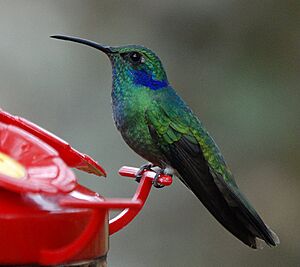Mexican violetear facts for kids
Quick facts for kids Mexican violetear |
|
|---|---|
 |
|
| Conservation status | |
| Scientific classification | |
| Genus: |
Colibri
|
| Species: |
thalassinus
|
 |
|
The Mexican violetear (Colibri thalassinus) is a beautiful, medium-sized hummingbird. It has shiny metallic green feathers. You can find this bird in forests from Mexico all the way south to Nicaragua. The Mexican violetear and the lesser violetear used to be thought of as the same bird, called the green violetear.
Contents
Amazing Hummingbird Facts
The Mexican violetear belongs to a group of birds called Apodiformes. This group also includes swifts. The name "Apodiformes" comes from ancient Greek words meaning "without foot." Even though these birds do have feet, they are very small and their legs are short and weak.
Birds in this group, like the Mexican violetear, can't really walk well. This means they almost never land on the ground. They are not good at finding food or escaping danger there. Instead, they spend most of their time flying in the air!
What Does the Mexican Violetear Look Like?
The Mexican violetear is a medium-sized hummingbird. It grows to be about 9.7 to 12 centimeters (around 4 to 5 inches) long. Its bill (beak) is black and mostly straight.
This bird weighs about 4.8 to 5.6 grams (less than an ounce!). Its wingspan is about 12 centimeters (around 4.7 inches).
It is a shining green color on its back. It has a bright violet patch on the sides of its neck, near its "ears." Its throat and chest are also a sparkling green. The tail is a metallic blue-green with a dark black band near the end.
How Mexican Violetears Communicate
Male Mexican violetears sing from high, open branches in their territory every day. Their song is a sharp, dry sound that they repeat over and over. It sounds like "tsu-tzeek" and they sing it about once every second.
Where Do Mexican Violetears Live?
Distribution and Range
The Mexican violetear breeds in the high mountain areas of southern Mexico. From there, it lives south into Nicaragua. Sometimes, it visits the United States, especially southern and central Texas. There have even been a few sightings as far north as southern Canada!
According to the IUCN (a group that tracks animal populations), you can find C. thalassinus in many mountain areas of the northern Andes, from Bolivia to Venezuela.
Preferred Homes
Mexican violetears like to live in the tops of trees and along the edges of forests. They also live in younger forests, bushy areas, and even gardens in warmer regions.
They are usually found at high altitudes, between 1,200 to 2,300 meters (about 3,900 to 7,500 feet) above sea level. However, they might fly down to 500 meters (about 1,600 feet) to find food. They really like humid, high-up places, like cloud forests.
What Mexican Violetears Eat
Mexican violetears usually look for food alone. But they often gather at flowering trees, especially coffee-shade Inga trees. They feed in the middle and upper parts of the trees. They often protect their feeding areas from other birds.
Their main food is nectar from flowers. They also eat small insects. These birds are quite common and can even do well in areas where forests have been cleared.
Mexican Violetear Reproduction
Like most hummingbirds, the Mexican violetear builds its nest alone. The male bird's only job in breeding is to attract and mate with the female. After that, the female does all the work.
The female chooses a safe spot for her nest, usually on a low, small branch. The nest is tiny and made from plant materials, spider webs, and soft down. These are woven together to make a strong, cup-shaped home.
She lays two small white eggs in the nest. The female then sits on the eggs to keep them warm (this is called incubation). This takes about 14 to 18 days. Once the babies hatch, the mother feeds them mostly insects. Insects are very important for their growth.
Traveling Habits
Scientists don't fully understand how Mexican violetears move around during the year. Many birds from northern areas fly south or to lower elevations after the breeding season ends. This happens from July to November in Mexico. But since they are sometimes seen far north of their usual range, it suggests they might have a more complex way of migrating.


